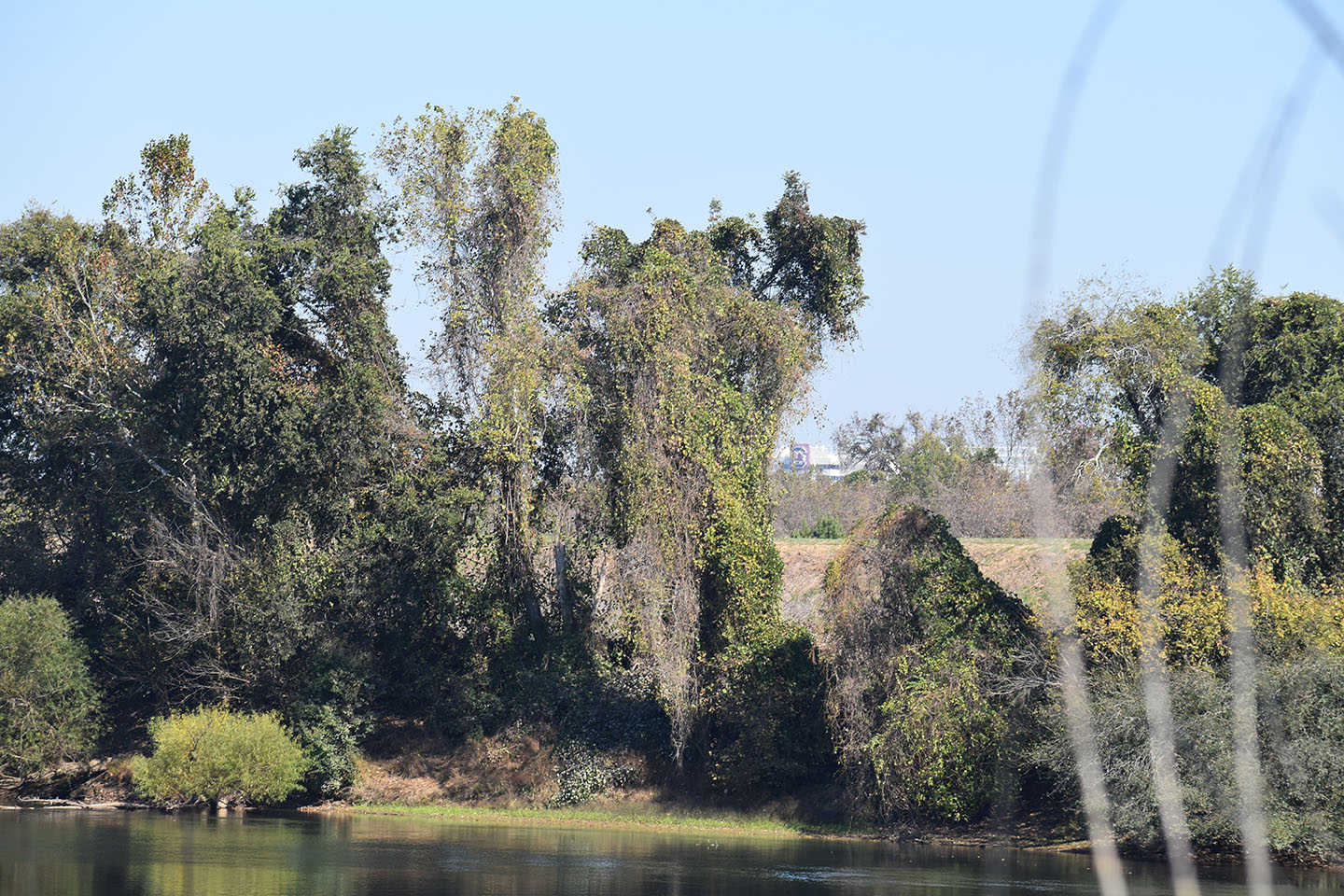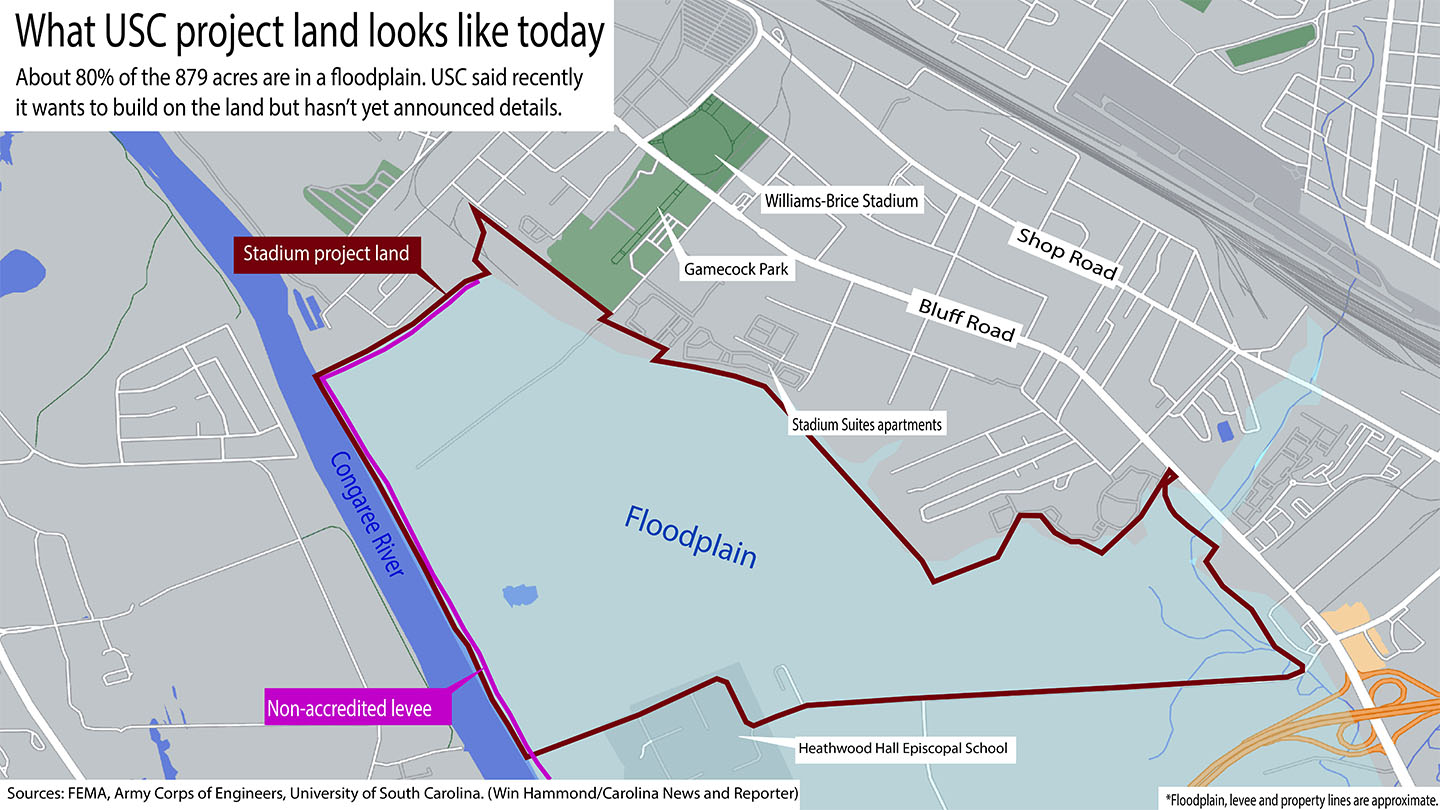Williams-Brice Stadium as seen from George Rogers Boulevard. (Photo by Win Hammond/Carolina News and Reporter)
USC announced in February a vision for its biggest project in modern history: developing more than 800 acres to create a vibrant, year-round shopping, dining and living experience near its 77,000-seat football stadium.
The massive project would use private developers to add a commercial hub to Columbia’s urban core between Williams-Brice Stadium and the Congaree River. The development would enhance fans’ game day experience and simultaneously reshape the city’s retail and tourism markets.
But it remains unclear if and how the University of South Carolina can overcome two of its biggest challenges – land that’s subject to flooding and a price tag that could exceed $1 billion.
Nine months after the announcement, school officials have yet to talk to local governments that have to approve the plans for what would be built and how soon this new part of the city would emerge.
The project and the property’s levees will require approval from Richland County. Many members of Richland County Council, including Chair Overture Walker and Vice Chair Jesica Mackey, said in late October the university had not contacted them about the project.
“I’m not aware of any plans or specifics,” Walker said.
The project first would renovate Williams-Brice to add more suite seating, better food facilities, more bathrooms and additional seating. Other recent renovations included $11 million in 2022 for new stadium lights, an upgraded sound system and new elevators. USC also spent $22.5 million on upgraded seating and renovations in 2020.
A better fan experience
The bulk of the project, though, isn’t focused on the stadium.
It involves nearly 900 acres of land owned by USC that’s mostly floodplain southeast of Williams-Brice, near the Congaree River.
The project is a huge investment. The university purchased the five parcels of land involved in the project piece by piece between 2013 and 2021. Land purchases cost the university more than $27 million.
Top university officials said upgrading the stadium and developing on land that’s below base flood elevation – a floodplain – could cost private developers more than $1 billion. USC hopes most of the project will be funded privately.
Most of the land used to be farmland that was covered in water in the city’s catastrophic flooding in 2015.
In a couple of years, it could be a giant economic catalyst for a part of Richland County left desolate when it isn’t football season.
The land is flat fields with ponds scattered throughout. The only development is USC’s 17-acre Huskey/Dietrich Golf Practice Facility, opened in 2016, and earthen levees built years ago along a portion of the Congaree.
It’s a far cry from what the university hopes the space could be.
USC Athletics leaders want fans to come to a game – and stay for a while.
“How can we get you for the entire day?” said Stephen Shapiro, a USC professor in sport and entertainment management.
“The idea behind it is we’re able to generate revenue in a lot of different ways,” Shapiro said. “If we create a better fan experience, people aren’t just going to games, they are staying there.”
Fans potentially could stay an entire weekend – or come when it’s not football season.
Williams-Brice hosts seven or eight home football games each year and is rarely patronized outside of football season.
Since the football stadium is off campus, USC’s ability to develop surrounding land is a rare opportunity for a big university in an urban environment.
“The fortunate side of being a mile off the campus is there’s a lot of land and space that they have to work with,” Shapiro said of Williams-Brice. “They can say, ‘All right, we haven’t been using this to its capacity. So let’s build a hotel. Let’s build condos. Let’s have retail.’”
Other urban schools with football stadiums away from their campus include the University of Miami and University of Pittsburgh, both of which share their stadiums with NFL teams. Miami’s and Pittsburgh’s stadiums are also located in the center of those cities, but they’re closely surrounded by developed city blocks. That’s not the case with Williams-Brice. Its neighbors are undeveloped land, student apartments and rock quarries.
Floodplain development isn’t impossible
One of the biggest obstacles in developing the nearly 900 acres is the land itself. It’s a floodplain.
Theoretically, there’s about a 1% chance of a floodplain flooding in any given year.
USC geography professor Dean Hardy said over the course of a 30-year mortgage, a house in a 100-year floodplain has a 26% chance of flooding.
But building in a floodplain isn’t impossible.
The 1600 Park Circle Condominiums at Pickens and Wheat streets, just off Blossom Street, abuts Rocky Branch Creek. The building has common areas at the bottom of the complex and residences above the base flood elevation, for example, Hardy said. It also has pillars holding it up.
Building in a floodplain also requires approval from the U.S. Army Corps of Engineers and Richland County, under its floodplain-specific building permits. The insurance also is expensive. That means more red tape for the university and developers and potentially more expenses.
If buildings can’t sit above where water would rise, builders are forced to build on pillars or add more land. Developers will dump dirt to elevate land to sit above the base flood elevation, adding huge labor and material cost to projects.
That kind of cost makes golf courses or recreational fields more appealing.
Building a golf course on the university’s land, for example, could be faster than building something like an apartment complex.
“Things like a golf course or something floods, that’s really not a huge problem,” Congaree Riverkeeper Bill Stangler said. “But putting buildings and people in harm’s way is just a bad idea.”
Stangler said if the university decided to build a condo complex in a floodplain for example, the university would “more than likely” end up in court.
Property has a history of failed developments
Other developers have attempted to do what USC hopes to do.
Developers of the project dubbed Green Diamond or “a city within a city,” planned to develop around 4,500 acres near Bluff Road.
High-end homes, retail space and golf courses were planned for the Green Diamond land. The project failed after a decade-long court battle between Richland County and the Myrtle Beach developers Burroughs & Chapin.
Richland County sued Burroughs & Chapin, alleging that hotels, condos and retail space in a floodplain would endanger business owners and residents of Cayce, across the river.
The state Supreme Court ruled in favor of Richland County in August 2015. The catastrophic flood of 2015 happened two month later.
Burroughs & Chapin isn’t the only firm to attempt building on the land.
William Gregg II was a prominent businessman in Columbia and served on the USC Educational Foundation board in the 1990s.
He filed for Chapter 13 bankruptcy in February 2013 after several development projects on the land, which he owned at the time, fell through.
Gregg owned a 298-acre parcel now owned by the university that he valued at more than $326 million. Other appraisers valued the same parcel of land as low as $400,000.
He wanted it to become a granite rock quarry. That would be more manageable in a flood, compared to something like an apartment complex, which he also tried developing on the land, and failed.
Gregg testified in August 2014 that the quarry could begin construction “in the next two months.” It was never built.
USC ended up bidding for and winning Gregg’s 298 acres between Bluff Road and the Congaree River.
Many people in Columbia hope that the university doesn’t create the next Green Diamond scandal.
“They’re going to build in the floodplain, and certainly I hope that’s not the case,” Stangler said. “It’s a fool’s errand.”
The university’s board of trustees on Sept. 15 gave university officials permission to approach developers about the stadium project, said USC spokesperson Jeff Stensland.
The Request For Proposal (RFP) process, which is needed to comply with state regulations, will ask developers to propose commercial projects on pieces of land they would lease from the university.
Stensland said the RFP likely won’t be put out for developers until early 2024.




